Primary Preventive Services Definitions
Pit and fissure sealants
They are defined as ” a cement or a resin which is introduced into unprepared occlusal pit and fissures of caries susceptible teeth forming a mechanical and physical protective layer against the action of acid-producing bacteria and their substrates”
Primary Preventive Services Important Notes
1. Disclosing agents
- Erythrosine red dye – common disclosing agent
- Bismark brown – plaque component of the Ramjford index uses this solution
- Two-tone solution – Stains mature plaque as green and immature plaque as red
- Mercurochrome
- Malachite green
2. Pit and fissure sealants
- They mainly act by physical obstruction of pits and grooves
- This prevents the penetration of fermentable carbohydrates so the remaining bacteria cannot produce acid
- Types:
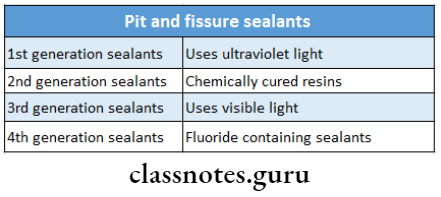
Pit and fissure sealants Indications:
- Presence of deep occlusal pits and fissures
- Presence of lingual pits or palatal pits in relation to upper lateral incisors and molars
- Presence of incipient lesion in pit and fissure
- Children and young people with medical, physical, and mental impairment with high caries risk
- Children and young people with signs of higher caries activity and coming from non-fluoride areas
Read And Learn More: Percentive Communitive Dentistry Question And Answers
Pit and fissure sealants Contraindications:
- Presence of shallow pits and fissures
- An open occlusal caries lesion with extension into the dentin
- Presence of large occlusal restoration
- Presence of interproximal lesions and rampant caries
- Partially erupted tooth where in isolation is a problem
- Uncooperative children
Preventive Care Guidelines
3. Interdental cleaning aids
Interdental cleaning aids is selected depending on the relative size of the embrasure
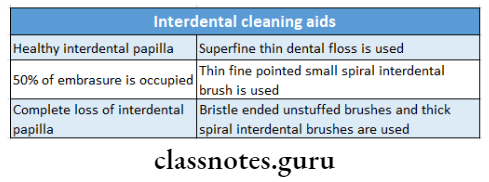
4. Lactobacillus colony test
- The Lactobacillus colony test is the oldest and most widely used microbiological method for assessing caries activity
- Measures the number of aciduric bacteria in the patient’s saliva
5. Swab test
- Developed by Grainger et al
- In it no collection of saliva is necessary
- Swab test is valuable in evaluating caries in very young children
Swab test Procedure:
- Swab the buccal surfaces of the teeth with a cotton applicator
- Incubate the sample in a media
- The change in pH over 48 hours of incubation is noted on a pH meter.
Swab test Interpretation:
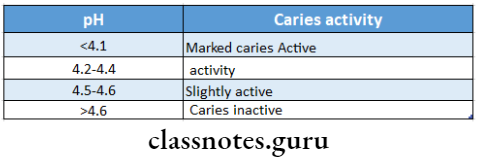
6. Snyder test
- Snyder test measures the ability of the salivary microorganism to form organic acids from a carbohydrate media
- Media contains bromocresol green dye which changes color from green to yellow in the range of pH 5.4 to 3.8
- Color observations

7.Salivaiy reductase test (or) Salivary Reductase Test.
Salivaiy reductase test measures the activity of the reductase enzyme present in salivary bacteria
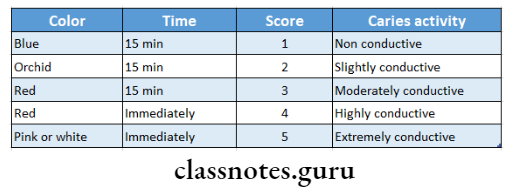
Examples Of Primary Preventive Care
8. Alban’s test
- Alban’s test is a simplified substitute for the Snyder test
- Can be used for routine dental office use
- At the time of the test, the patient is asked to spit unstimulated saliva directly into the tube and it is incubated for 4 days.

Primary Preventive Services Short Essays
Question 1. Bisbiguanides/ Chlorhexidine.
Answer:
Bisbiguanides
Chlorhexidine gluconate and alexidine are the most effective biguanides
Bisbiguanides Chlorhexidine Gluconate:
Bisbiguanides Indications:
- As an adjunct to mechanical methods
- Immediately after pack removal
- After oral surgical procedures
- In patients with fixed appliances
- For handicapped patients
- Drug-induced gingival enlargements
- Medically compromised patients
- Acute infections
- As prophylactic rinse
Bisbiguanides Adverse Effects:
- Staining of teeth
- Burning sensation
- Impaired taste sensation
- Rarely, parotid swelling
Bisbiguanides Mechanism:
- In low concentrations- bacteriostatic
- Cationic molecules of chlorhexidine bind to the anionic molecules of bacterial cell wall
- Interferes with membrane transport
- Results in leakage of the substance
- In high concentrations- bacteriocidal
- Penetration of chlorhexidine into the cell
- Precipitation of cytoplasm
Bisbiguanides Effective Concentration:
10 ml of 0.2%
Preventive Services Questions
Question 2. Caries vaccine
(or) Describe the routes of immunization of dental caries vaccine.
Answer:
Caries vaccine
caries vaccine is a suspension of an attenuated or killed microorganism administered for the prevention, amelioration, or treatment of infectious diseases
Caries vaccine Mechanism Of Action:
- When the tooth erupts serum antibodies i.e. IgA stimulate opsonization and phagocytosis
- These antibodies have an inhibitory effect on glucosyl transferase and on acid production
- Caries vaccine results in the inhibition of the metabolic activity of S.mutans on teeth
Caries vaccine Route Of Administration:
- Oral route
- Increases stimulation of IgA antibodies
- Systemic route
- Subcutaneous administration of s.mutans led to an increase in IgG, IgM and IgA antibodies
- Active gingival-salivary route
- Localizes the immune response by using gingival crevicular fluid as a route
- Active immunization
- Synthetic peptides
- Derived from glucosyl transferase enzyme
- Synthetic peptides
- Coupling with cholera toxin subunits
- Coupling of the protein with a nontoxic unit of cholera toxin suppresses colonization of S. mutans
- Fusing with avirulent strains of salmonella
- Liposomes- increases IgA antibodies
- Passive immunization
- External supplements are included
- Bovine milk and whey
- Egg yolk
- Transgenic plants

Question 3. Preventive resin restoration.
Answer:
Preventive resin restoration
Preventive resin restoration utilizes the invasive and non-invasive treatment of borderline or questionable caries
Preventive resin restoration Indications:
- Deep pit and fissure
- Minimal/small carious lesion » Isolated carious lesion
Preventive resin restoration Advantages:
- Conservative technique
- Cessation of tooth destruction
- Can be replaced easily
Question 4. Chemical plaque control.
Answer:
Chemical plaque control Uses:
- As adjunct
- Prevents recurrence of disease
- Chemical plaque control may involve the prevention of plaque formation
- Removal of existing plaque
- Inhibition of calcification of existing plaque
- Altering the pathogenicity of plaque
Classification of Chemical plaque control:
- First generation
- Reduces plaque score by 20-50%
- Example: Antibiotics
- Second generation
- Reduces plaque score by 70-90%
- Example: Bisbiguanides
- Third generation
- Effective against specific organisms
Chemical plaque control Chemical Used:
- Antibiotics
- Erythromycin
- Penicillin
- Enzymes
- Lipase
- Amylase
- Quaternary ammonium compounds
- Benzalkonium chloride
- Bisbiguanide
- Chlorhexidine
- Metallic salts
- Copper
- Zinc
- Herbal extracts
- Phenols
- Hydrogen peroxide
- Fluorides
- Others
- Triclosan
Types Of Preventive Care
Question 5. Anti caries mouth rinses.
Answer:
Anti-caries mouth rinses
- Formulated at
- 0.2% concentration- for weekly use
- 0.05% concentration- for daily use
- Preparation
- Prepared by dissolving 200 mg sodium fluoride tablet in 5 teaspoons of fresh clean water « It can be used for 4 members (2 adults and 2 children)
- Mechanism
- Fluoride forms fluorapatite from hydroxyapatite
- Fluoride inhibits bacterial metabolism and plaque acid formation
- Indications
- If the concentration of fluoride in drinking water is 0.3 ppm or less
- Patients with increased caries risk
- School fluoride programs
- Advantages
- 30-40% reduction in caries incidence
Question 6. Pit and fissure sealants
(or)Classify pit and fissure sealants. Write about indications and contra-indications.
Answer:
Pit and fissure sealants
They are defined as ” a cement or a resin which is introduced into unprepared occlusal pit and fissures of caries susceptible teeth forming a mechanical and physical protective layer against the action of acid-producing bacteria and their substrates”
Pit and fissure sealants Indication:
- Children of less than 4 years of age
- Newly erupted teeth
- Stained pits and fissures
Pit and fissure sealants Contraindication:
- Low carious risk patients
- Wide pit and fissure
- Partially erupted teeth
Pit and fissure sealants Classification:
- Based on polymerization
- Self-activation
- Light activation
- Resin systems
- BIS-GMA
- Urethane acrylate
- Clear or tinted
Pit and fissure sealants Ideal Requisites:
- Easily flowable into the deep pit and fissure
- Easy and quick to apply and cure
- Should result in prolonged retention
- Must have cariostatic properties
- Must be nonirritant
- Should have wear resistance property
Pit and fissure sealants Procedure:
- Surface cleanliness of the tooth
- Dryness of the tooth surface
- Preparing the tooth for sealant application
- Application of the sealant
Primary Prevention In Healthcare
Question 7. Lactobacillus test.
Answer:
Lactobacillus test
Described by Hadley in 1933
Lactobacillus test Principle:
Lactobacillus test Principle estimates the number of acidogenic bacteria in a patient’s saliva by counting the number of colonies appearing on agar
Lactobacillus test Procedure:
- Collect paraffin-stimulated saliva (5-10 ml)
- Dilute to 1:10 dilution by pipetting 1 ml of saliva into a 9 ml tube of sterile saline solution
- Similar again to 1:100 dilution using a 1:10 diluted sample
- Mix thoroughly
- Spread 0.4 ml of each dilution over agar plates
- Incubate for 3-4 days at 37° C
- Count the number of colonies
Result:
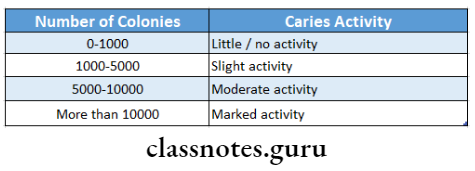
Lactobacillus test Disadvantages:
- Inaccurate
- Require complex equipment
- Time-consuming
- Tedious
Question 8. Self-control of plaque.
Answer:
The self-control of plaque Measures:
The self-control of plaque Toothbrush:
- The self-control of plaque ADA’S specification
- Tooth head should be
- 1-11/4* inch in length
- 5/16- 3/8 inches in width
- 2-4 rows of bristles
- 5-12 tufts per row
- Soft- 0.007-0.009 rows
- 80-86 bristles per tufts
- The self-control of plaque Types
- Based on the diameter of the bristles
- Soft- 0.007-0.009 inches
- Medium- 0.010-0.012 inches
- Hard- 0.013-0.014 inches
- Extra hard- 0.015 inches
- Based on the diameter of the bristles
- The self-control of plaque Based on the use
- Frequency of brushing
- Every 12 hours
- The self-control of plaque Frequency of change of brush
- Every 3 months
- Length of brushing time
- Initially 10-20 minutes
- Later 3-5 minutes
- The self-control of plaque Dentrifices
- Used in the form of powder, paste, or gels
- Interdental cleansing aids
- Used in periodontally-involved patients
- Used in open embrasures
- Various aids
- Dental floss o Interdental brushes
- Wooden tips
- Yams, gauze strips
- The self-control of plaque Gingival massage
- Device used
- Toothbrush
- Rubber tip stimulator
- Interdental cleaning device
- The self-control of plaque Effects
- Epithelial thickening
- Increased keratinization
- Increased mitotic activity
- The self-control of plaque Oral irrigation
- Clean non
- adherent bacteria debris
- Disrupt and detoxify subgingival plaque
- Delivers anti-microbial agents into the periodontal pocket
Preventive Services Q&A
Question 9. Erythrosine dye.
Answer:
Erythrosine dye
Erythrosine dye is a cherry-pink synthetic agent
Erythrosine dye Uses:
- Food coloring agent
- In printing inks
- Biological stain
- Disclosing agent
- Radiopaque medium
- Sensitizer
- Used in sweets, in cakes decorating gels
Erythrosine dye Concentration:
- For rinsing
- Red no 3- 6.0 g
- Water to make: 100 ml
- For topical application
- Erythrosine: 0.8 g
- Distilled water-100 ml
- Alcohol 95%-10 ml
- Peppermint oil: 2 drops
- Erythrosine dye Tablets
- Red no 3 -15 g
- Sodium chloride- 0.747 %
- Sodium sugary: 0.747 %
- Calcium stearate: 0.995%
- Soluble saccharin: 0.186%
- White oil: 0.124%
- Flavoring: 2.239%
- Sorbitol
Erythrosine dye Purpose:
- Patient’s education
- Evaluate the effectiveness of the treatment
- Evaluate plaque indices
- Self-evaluation
Question 10. Toothbrush.
Answer:
Toothbrush Ada’s Specification:
- Tooth head should be
- 1-11/4^ inch in length
- 5/16-3/8 inches in width
- 2-4 rows of bristles
- 5-12 tufts per
- Soft- 0.007-0.009 rows
- 80-86 bristles per tufts
Toothbrush Types:
- Based on the diameter of the bristles
- Soft- 0.007-0.009 inches
- Medium- 0.010-0.012 inches
- Hard-0.013-0.014 inches
- Extra hard- 0.015 inches
- Based on use
- Manual
- Automatic
- Sonic and ultrasonic
- Ionic
- Frequency of brushing
- Every 12 hours
- Frequency of change of brush
- Every 3 months
- Length of brushing time
- Initially 10-20 minutes
- Later 3-5 minutes
Toothbrush Objectives Of Brushing:
- To clean teeth and interdental space
- To prevent plaque formation
- To remove plaque
- To stimulate and massage gingival tissue
- To clean tongue
Toothbrush Parts:
- Handle
- Head
- Tufts
- Brushing plane
- Shank
Healthcare Prevention Strategies
Question 11. Bass technique.
Answer:
Bass technique Synonym:
Sulcus cleaning method
Bass technique Indications:
- Open interproximal areas
- Routine technique
- Exposed root surfaces
Bass technique Technique:
- Place the bristles at a 45° angle to gingival
- Move in small circular motions
- Cover 3 teeth at a time
- Repeat around 20 strokes
- For occlusal surfaces
- Press the bristles firmly against pits and fissures
- Activate the bristles
- For lingual surfaces of the anterior place the brush vertically
Bass technique Advantages:
- Easy
- Effective
- Stimulate gingiva
Bass technique Disadvantages:
- Can cause gingival injury
- Time-consuming
- Require dexterity
Question 12. Classification of dental caries.
Answer:
Classification of dental caries Clinical:
- According to the stage of lesion progression
- Non cavitated
- Cavity
- According to the severity of the disease
- Acute
- Chronic
- Stabilized
- According to clinical manifestation
- White spot lesion
- Superficial caries
- Medium caries
- Deep caries
- Secondary caries
Classification of dental caries Anatomical:
- According to anatomical depth
- Enamel caries « Dentinal caries
- Cementum caries
- According to location
- Coronal caries
- Occlusal caries
- Smooth surface caries
- Approximal caries
- Root caries
Question 13. Caries activity tests.
(or) Synder’s test
Answer:
1. Synder’s Test:
Synder’s Test is used for lactobacillus count
Caries activity tests Procedure:
- Paraffin-stimulated saliva is collected in test tubes
- It is inoculated into glucose and agar media
- pH 4.7-5.0 is maintained along with color indicator bromocresol green
- The color change indicates pH change and is compared to the standardized color chart and scored
- Recordings are carried out at the end of 24 hours, 48 hours and 72 hours
Result:
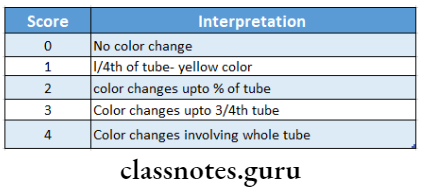
2. Lactobacillus Test:
Described by Hadley in 1933
Caries activity tests Procedure:
- Collect paraffin-stimulated saliva [5-10 ml)
- Dilute to 1:10 dilution by pipetting 1 ml of saliva into a 9 ml tube of sterile saline solution
- Similar again to 1:100 dilution using a 1:10 diluted sample
- Mix thoroughly
- Spread 0.4 ml of each dilution over agar plates
- Incubate for 3-4 days at 37° C
- Count the number of colonies
3. Swab Test:
Caries activity tests Procedure:
- The oral flora is sampled by swabbing the buccal surfaces of the teeth with a cotton applicator
- Caries activity tests is subsequently incubated in the medium
- The change in pH following a 48-hour incubation period is read on a pH meter
Interpretation:
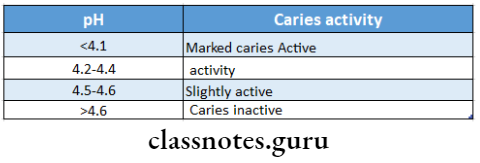
Difference Between Primary And Secondary Prevention
Question 14. Modified bass technique.
Answer:
Bass technique
- Placement of the head of the brush
- 45° to the long axis of the teeth
- Initial from most posterior teeth
- Method
- Place the brush covering 3 most posterior teeth
- Exert gentle pressure
- Use short back and forth motions complete 20 strokes
- Sweep the bristles occlusal
- Repeat it for remaining teeth both buccally and lingually
- For occlusal surfaces, press bristles into pits and fissures and exert strokes
- For lingual surfaces of the anterior, place the brush vertically
Primary Preventive Services Short Question And Answers
Question 1. Interdental cleansing aids.
Answer:
Interdental cleansing aids Uses:
- Used in periodontally-involved patients
- Used in open embrasures
- Removes plaque and debris adherent
- Polishes the surfaces
- Massage the inter-dental papillae
- Reduces gingival bleeding
- Contribute to general oral sanitation
- Controls halitosis
- Various Aids:
- Dental floss
- Interdental brushes
- Wooden tips
- Yarns, gauze strips
Question 2. ADA’s specification of the toothbrush.
Answer:
ADA’s specification of the toothbrush
- Tooth head should be
- 1-1 l/4th inch in length o 5/16-3/8 inches in width
- 2-4 rows of bristles
- 5-12 tufts per
- Soft- 0.007-0.009 rows
- 80-86 bristles per tufts
Question 3. Disclosing agents.
Answer:
Disclosing agents
- They are prepared in liquid, tablet, or lozenge form that contains a dye or other coloring agent
- Disclosing agents is used to identify bacterial plaque for instruction, evaluation and research
Disclosing agents Purpose:
- Patient’s education
- Evaluate the effectiveness of the treatment
- Evaluate plaque indices
- Self-evaluation
Disclosing agents Requirements:
- Color should contrast with the normal color of the oral cavity
- Disclosing agents should not rinse off immediately
- Disclosing agents should not cause any irritation
- Disclosing agents should be thin enough
Disclosing agents Agents
- Iodine containing preparation
- Bismarck brown
- Merbromin
- Erythrosine
- Fast green
- Two-tone
Question 4. Synder’s test.
Answer:
Synder’s test
Synder’s test is used for lactobacillus count
Synder’s test Procedure:
- Paraffin-stimulated saliva is collected in test tubes
- Synder’s test is inoculated into glucose ft agar media
- pH 4.7-5.0 is maintained along with color indicator bro- mo cresol green
- The color change indicates pH change it is compared to the standardized color chart ft scored
- Recordings are carried out at the end of 24 hours, 48 hours, and 72 hours
Benefits Of Primary Prevention
Question 5. Dental floss.
Answer:
Dental floss Types:
- Twisted or non-twisted
- Bonded or non-bonded
- Waxed or unwaxed
- Thick or thin
Dental floss Technique:
- Wrap the dental floss around the fingers
- Stretch it between the forefinger ft thumb
- Pass interproximal through each contact area in the back-forth motion
- Move the floss along the tooth apically upto sulus
- Repeat it
Dental floss Functions:
- Removal of adherent plaque ft debris interdentally
- Polish tooth surface
- Stimulate ft massage interdetnal papilla
- Help to locate
- Subgingival calculus
- Proximal caries
- Overhanging margins
- Dental floss is a vehicle for applying polishing / therapeutic agents
Question 6. Charter’s method.
Answer:
Charter’s method Method:
- Place the bristles 45° angle to the long axis of teeth pointing coronally
- Flexed against the gingiva
- Back-and-forth vibratory motions are given
Charter’s method Indication:
After surgery
Charter’s method Effect:
- Gingival stimulation
- Interproximal cleansing
Question 7. Chlorhexidine.
Answer:
Chlorhexidine Indications:
- As an adjunct to mechanical methods
- Immediately after pack removal
- After oral surgical procedures
- In patients with fixed appliances
- For handicapped patients
- Drug-induced gingival enlargements
- Medically compromised patients
- Acute infections
- As prophylactic rinse
Chlorhexidine Adverse Effect:
- Staining of teeth
- Burning sensation
- Impaired taste sensation
- Rarely, parotid swelling
Chlorhexidine Mechanism:
- In low concentrations- bacteriostatic
- Cationic molecules of chlorhexidine bind to the
- ionic molecules of bacterial cell wall
- Interferes with membrane transport
- Results in leakage of the substance
- In high concentration-bacteriocidal
- Penetration of chlorhexidine into a cell i
- Precipitation of cytoplasm
Chlorhexidine Effective Concentration:
10 ml of 0.2%
Question 8. Active immunization for dental caries.
Answer:
- As an adjunct to mechanical methods
- Immediately after pack removal
- After oral surgical procedures
- In patients with fixed appliances
- For handicapped patients
- Drug-induced gingival enlargements
- Medically compromised patients
- Acute infections
- As prophylactic rinse
Question 9. Roll on technique.
Answer:
Roll on technique Synonym:
- ADA method
- Sweep method
Roll-on technique Indications
- Preparatory for modified Stillman method
- Children
- Adults with limited dexterity
Roll on technique Technique:
- Place the bristles at a 45° angle to tooth surfaces
- Lightly roll over it occlusal
Roll on technique Advantage
Massage and stimulate gingiva
Roll-on technique Disadvantage:
- Lacerate alveolar mucosa
- Ineffective for the cervical third of the tooth and interproximal areas
- May produce punctuate lesions
Preventive Care Guidelines
Question 10. Dentrifices.
Answer:
Dentrifices
- Dentrifices is a substance used with a toothbrush for the purpose of
- cleaning the accessible surfaces of teeth
- Used in the form of powder, paste, or gel
Dentrifices Functions:
- Minimize plaque build-up
- Anticaries action e Removal of stains
- Mouth freshener
Dentrifices Composition
- Abrasive
- Calcium carbonate
- Calcium phosphate
- Humectants
- Maintains moisture
- Glycerine, sorbitol
- Preservatives
- Benzoic acid
- Thickening agents
- Methylcellulose
- Foaming agents
- Sodium lauryl sulfate
- Flavoring agents
- Mint
- Sweetening agents
- Mannitol, saccharine
- Desensitizing agents
- Sodium fluoride
- Anticalculus agent
- Pyrophosphates
Question 11. Uses of chlorhexidine.
Answer:
Uses of chlorhexidine
- As an adjunct to mechanical methods
- Immediately after pack removal
- After oral surgical procedures
- In patients with fixed appliances
- For handicapped patients
- Drug-induced gingival enlargements
- Medically compromised patients
- Acute infections
- As prophylactic rinse
Question 12. Caries vaccine.
Answer:
Caries vaccine
Caries vaccine is a suspension of an attenuated or killed microorganism administered for the prevention, amelioration or treatment of infectious diseases
Caries vaccine Mechanism Of Action:
- When the tooth erupts serum antibodies i.e. IgA stimulate opsonization and phagocytosis
- These antibodies have an inhibitory effect on glucosyl transferase and on acid production
- It results in the inhibition of the metabolic activity of S.mutans on teeth
Question 13. Indications of a powered toothbrush.
Answer:
Indications of a Powered Toothbrush
- Young children
- Handicapped patients
- Individuals lacking manual dexterity
- Patients with prosthodontic or endosseous implants
- Orthodontic patients
- Institutionalized patients including the elderly who are dependent on care providers
- Patients on supportive periodontal therapy
Preventive Care Guidelines
Question 14. Salivary reductase test.
Answer:
Salivary reductase test Procedure:
- Paraffin-stimulated saliva is collected in a collection tube
- Salivary reductase test is then mixed with the dye Diazo-resorcinol
- The caries conduciveness reading or color change is done after 15 minutes
Question 15. Spool method of flossing.
Answer:
Spool method of flossing
- About 12-18 inches long floss is taken and about 4 inches from each end is wound around the middle finger of each hand
- In both hands, the last three fingers are folded and closed and both hands are moved apart
- In this way, about 1-2 inches of floss is held tightly between the index fingers of both hands
Primary Preventive Services Viva Voce
- Fredick Tornberg was the first to design the powered toothbrush
- The circular method of toothbrushing technique is called the Fones technique
- The vertical method of brushing technique is called the Leonard method
- Smith method is a physiological method of toothbrushing
- The bristles in the bass method are placed at a 45-degree angle to the gingiva
- Dental floss is indicated to remove plaque from type I gingival embrasure
- Furcation areas are difficult to access with dental floss
- The spool method of flossing is used in adults with good manual dexterity
- Waxed floss makes a squeaking noise when passed interproximal
- Gingival physiotherapy results in better gingival health through increased blood flow
- The bound chlorhexidine is slowly released in the active form for a period of 12-24 hours
- Triclosan is a phenol derivative present as an antiplaque agent
- Brown staining of chlorhexidine is due to the precipitation of salivary melanoidin’s
- Humectant present in toothpaste helps in reducing loss of moisture
- Sodium lauryl sulfate is the detergent present in toothpaste
